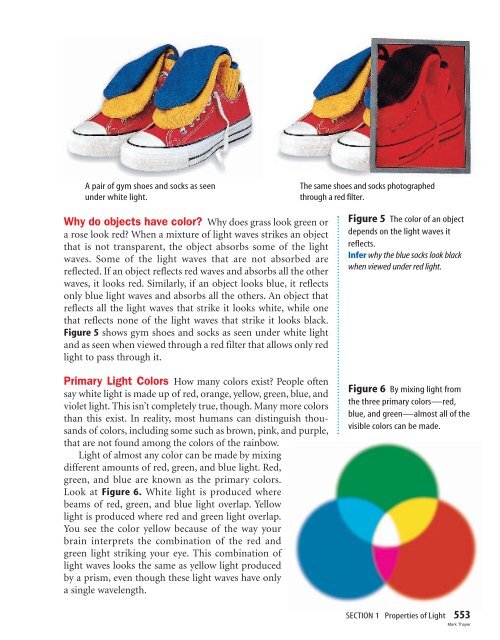A pair of gym shoes <strong>and</strong> socks as seenunder white light.The same shoes <strong>and</strong> socks photographedthrough a red filter.Why do objects have color? Why does grass look green ora rose look red? When a mixture of light waves strikes an objectthat is not transparent, the object absorbs some of the lightwaves. Some of the light waves that are not absorbed arereflected. If an object reflects red waves <strong>and</strong> absorbs all the otherwaves, it looks red. Similarly, if an object looks blue, it reflectsonly blue light waves <strong>and</strong> absorbs all the others. An object thatreflects all the light waves that strike it looks white, while onethat reflects none of the light waves that strike it looks black.Figure 5 shows gym shoes <strong>and</strong> socks as seen under white light<strong>and</strong> as seen when viewed through a red filter that allows only redlight to pass through it.Primary <strong>Light</strong> Colors How many colors exist? People oftensay white light is made up of red, orange, yellow, green, blue, <strong>and</strong>violet light. This isn’t completely true, though. Many more colorsthan this exist. In reality, most humans can distinguish thous<strong>and</strong>sof colors, including some such as brown, pink, <strong>and</strong> purple,that are not found among the colors of the rainbow.<strong>Light</strong> of almost any color can be made by mixingdifferent amounts of red, green, <strong>and</strong> blue light. Red,green, <strong>and</strong> blue are known as the primary colors.Look at Figure 6. White light is produced wherebeams of red, green, <strong>and</strong> blue light overlap. Yellowlight is produced where red <strong>and</strong> green light overlap.You see the color yellow because of the way yourbrain interprets the combination of the red <strong>and</strong>green light striking your eye. This combination oflight waves looks the same as yellow light producedby a prism, even though these light waves have onlya single wavelength.Figure 5 The color of an objectdepends on the light waves itreflects.Infer why the blue socks look blackwhen viewed under red light.Figure 6 By mixing light fromthe three primary colors—red,blue, <strong>and</strong> green—almost all of thevisible colors can be made.SECTION 1 Properties of <strong>Light</strong> 553Mark Thayer
Figure 7 The three primarycolor pigments—yellow,magenta, <strong>and</strong> cyan—can formalmost all the visible colors whenmixed together in variousamounts.Primary Pigment Colors Materials like paint that are usedto change the color of other objects, such as the walls of a roomor an artist’s canvas, are called pigments. Mixing pigmentstogether forms colors in a different way than mixing coloredlights does.Like all materials that appear to be colored, pigments absorbsome light waves <strong>and</strong> reflect others. The color of the pigmentyou see is the color of the light waves that are reflected from it.However, the primary pigment colors are not red, blue, <strong>and</strong>green—they are yellow, magenta, <strong>and</strong> cyan. You can makealmost any color by mixing different amounts of these primarypigment colors, as shown in Figure 7.Although primary pigment colors are not the same as theprimary light colors, they are related. Each primary pigmentcolor results when a pigment absorbs a primary light color. Forexample, a yellow pigment absorbs blue light <strong>and</strong> it reflects red<strong>and</strong> green light, which you see as yellow. A magenta pigment, onthe other h<strong>and</strong>, absorbs green light <strong>and</strong> reflects red <strong>and</strong> bluelight, which you see as magenta. Each of the primary pigmentcolors is the same color as white light with one primary colorremoved.Summary<strong>Light</strong>•<strong>and</strong> Matter<strong>Light</strong> is an electromagnetic wave that can•travel in a vacuum as well as through matter.When light waves strike an object some lightwaves might be absorbed by the object, somewaves might be reflected from the object, <strong>and</strong>•some waves might pass through the object.Materials can be opaque, translucent, ortransparent, depending on how much lightpasses through the material.•Color<strong>Light</strong> waves with different wavelengths have•different colors.White light is a combination of all the colors•ranging from red to violet.The color of an object is the color of the light•waves that it reflects.The primary light colors are red, green, <strong>and</strong>blue. The primary pigment colors are yellow,magenta <strong>and</strong> cyan.Self Check1. Diagram the path followed by a light ray that entersone of your eyes when you are reading at night in aroom.2. Determine the colors that are reflected from an objectthat appears black.3. Compare <strong>and</strong> contrast primary light colors <strong>and</strong> primarypigment colors.4. Describe the difference between an opaque object <strong>and</strong>a transparent object.5. Think Critically A white shirt is viewed through a filterthat allows only blue light to pass through the filter.What color will the shirt appear to be?6. Draw Conclusions A black plastic bowl <strong>and</strong> a whiteplastic bowl are placed in sunlight. After 15 minutes,the temperature of the black bowl is higher than thetemperature of the white bowl. Which bowl absorbsmore light waves <strong>and</strong> which bowl reflects more lightwaves?554 CHAPTER 19 <strong>Light</strong>, <strong>Mirrors</strong>, <strong>and</strong> <strong>Lenses</strong>ips.msscience.com/self_check_quiz

















